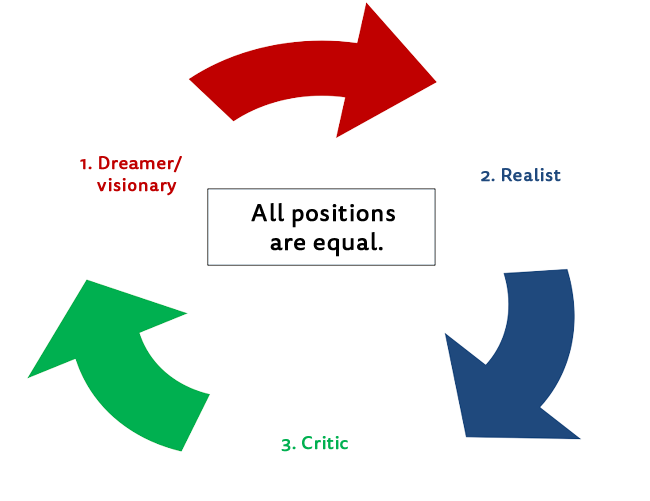Self-management and organization – How to define goals and put them into practice (Part 2)
In my previous blog article from February, I explained George T. Doran’s SMART formula, which is a proven way for defining achievable goals. In my article, I promised you a second part introducing another method: the Disney Method. It’s named after Walt Disney, who ran his company according to this approach, and with highly successful results.
The Disney Method
Visionary and perfectionist Walt Disney created this organizational model. He first explained his approach to work in an interview with Robert Dilts: He’d created for himself three different “thinking chairs” – one for the “dreamer/visionary,” one for the “realist” and one for the “critic.”
Whenever he sat on the chair of the dreamer, he allowed himself to
- be creative,
- come up with dreams,
- collect ideas and solutions,
- have a positive attitude where anything at all was allow.
Once he had finished with the respective thought processes, he moved on to the chair of the realist. On that chair, based on the ideas of the visionary, he only allowed himself, with logic and realism, to
- develop concrete implementation steps (plan),
- put together whatever was needed for implementation,
- distribute the tasks,
- and determine the implementation costs.
When this perspective was also completed, he sat down in the critic’s chair. Here, in response to the realist, he only allowed himself to
- carry out evaluations,
- identify risks and dangers,
- think of potential threats,
- look for any weak points and
- find opportunities for improvement.
He switched between chairs and roles until he was comfortable in all three chairs. Then he separated the thinking chairs both in terms of time and space to avoid disruptions in the process and to be able to fully engage in one view at a time. Later on, he also set up respective rooms in his company for his employees. This is how Walt Disney passed on his work approach to his entire team.

I invite you to give this method a try. In my next article I’ll show you how to transfer the Disney Method to self-coaching.
If you have any questions or would like me to write about a specific topic, feel free to contact me any time. And as always:
Go for it,
Your crisis manager
Self-management and organization – How to define goals and put them into practice (Part 1)
In the personal sphere, we all like to set goals for ourselves, typically in the form of New Year’s resolutions. In the professional context, we tend to talk about projects. In most cases, however, it remains unclear as to whether we’ll achieve these goals – either resolutions or projects.
Why is that?
First, we need to ask ourselves whether we’re really, truly keen on pursuing a specific project: Are we intrinsically motivated to do so? Implementation tends to fail because the respective goals were defined at the wrong time or, as the case may be, not correctly defined in the first place.
A proven means for defining goals, which also fundamentally increases the likelihood of implementation, is the so-called SMART formula.
In this blog I’d like to present this very formula to you – even though you may already be familiar with it – as I consider it to be valuable and pragmatic. Let me direct your focus to it once again:
Defining goals according to the SMART formula
The five letters making up the acronym SMART each stand for a specific aspect of the goal, the definition of which should make it both concrete and attainable:
S = specific
M = measurable
A = attractive
R = realistic
T = time-phased
In addition to focusing on these aspects, however, it’s important to consider further steps in the goal formulation so that the envisioned and planned goal can be successfully implemented. Unfortunately, these further steps are often overlooked or forgotten about in practice.
Here’s a possible sequence:
- Goals should be phrased in the present tense. In other words, grammatically, we “act” as if we’ve already achieved them.
- The goal should be as specific and concrete as possible (e.g., “I am the leader of the XY-team.” or “I am slimmer.”).
- In addition, it should be measurable, so that we make achieving it as concrete as possible (e.g., “I am in charge of 10 employees.” or “I weigh 10 kg less.”)
- The goal should be attractive, in other words, desirable, so that we are truly motivated to make the effort to attain it. The more attractive, the higher our intrinsic motivation. Our motivation is also increased if the goal is not just factually appealing, but emotionally appealing, too.
- The goal should also be realistic. Of course, it’s fine to set oneself big goals, but they must always be achievable. The more realistic the definition of a goal, the more likely it is that we will pull it off.
- Many goals are never achieved because they are not scheduled. The many unachieved New Year’s resolutions are a typical example of this. Often, they simply peter out. In other words, a well-defined goal should include a target date. (e.g., “On March 31, 2022, I will be responsible for team XY.” or “On September 1, 2022, I will weigh 10 kg less.”)
- Another important aspect is the to use the “I” form. Because of course it is I who wants to achieve the goal and not someone else.
- Also, the achievement of the goal should be independent of any conditions. So, it should not contain any “if x then y" connections. Conditions such as these would make us too dependent on the “if” event, which may be beyond our control.
- And finally, the goal should be achievable without any external help or support, in other words, through our own efforts. Otherwise, we may be putting ourselves in an unfavorable position of dependency.
While at first, it may look as if you need to plan for plenty of time for each goal, this is not the case. You may require a little more concentration at the beginning. But once the application is put into practice, things tend to start moving very quickly – and all the more effectively.
Of course, the SMART formula in and of itself is not a guarantor for goal achievement and implementation, but it certainly takes us a significant step closer to reaching our concrete goals.
In my next blog article, I’ll share with you what additional aspects you should take into account, what alternative ways there are to proceed and what we can possibly do cumulatively.
If you have any questions or are looking for any specific input, just let me know. And as always:
Go for it,
Your crisis manager
Good communication in an online setting
Hello to you and all the best for a happy and healthy 2022!
And of course, let me also welcome you to part four of our “Good communication in an online setting” blog series. This time, I’d once again like to address some of the special aspects of the various communication levels – tonal and non-verbal, gestures and facial expression.
I’ve also added a small exercise for you – I invite you to go ahead and give it a try. Let me know how it works out for you!
Nonverbal communication
Facial expression:
It’s helpful for the speaker to have a friendly facial expression. An open smile at the beginning establishes a connection with the audience. Even if it isn’t 100% heartfelt at the beginning, as soon as a friendly person smiles back – and this is guaranteed to happen! – you’ll have created a bridge between yourself and the audience and a connection will have been made. A smile, however, shouldn’t grow into a permanent grin.
Eye contact:
Eye contact simply cannot be overestimated – it engages the audience. By making good eye contact, you as a speaker will come across as confident and believable. Eye contact shows appreciation and helps the audience to feel seen as individuals. In addition, as a speaker, you’ll only be able to understand the nonverbal response of the other person if you have them in your sight. What’s more, by making eye contact, you’re virtually “commanding” the listener’s attention.
Yet, make sure you don’t stare too strongly at anyone, as this may unnerve the person you’re looking at. Similarly, avoid letting your eyes flit back and forth too much between people as this conveys insecurity rather than truly taking in the person you’re talking to.
Gestures:
Gestures are part of our normal conversational behavior, which is why it would be downright unnatural to suppress them during video conferences!
Gestures should underline what is being said, not counter it. Between gestures, your hands should return to a resting position – otherwise, the use of hands and arms may quickly come across as “flailing about” and distract from, instead of emphasize, the content.
Posture:
If possible, stand up during video conferences. Standing up gives you much more control over what is happening; simply by being upright, you’re giving your appearance more impact. Don't shift your weight from one foot to the other, as this easily looks like “rocking” and tends to make the audience nervous or distract them from what’s being said.
Taking a small step towards the “audience” or video camera can underline what you’re saying. However, you shouldn’t constantly be striding forward and backward, as this also can come across as quite restless and distracting.
Tonal communication
Voice:
Your most important tool when it comes to speaking is your voice! And like any tool, it needs to be well looked after and not used carelessly. The cornerstone of your voice is your breath, which naturally accompanies us every day and occurs automatically.
We can also intentionally use our breath to make our voice stronger – and to get any nervousness under control, because if you’re breathing calmly, you can’t be agitated.
Exercise “Conscious abdominal breathing”
A regular breathing pattern calms your body down. That’s why it’s important, in everyday life, to pay attention to breathing slowly and consciously into your abdomen. Get used to a counting rhythm. Slowly count to four as you inhale and then again slowly count to four as you exhale.
Lie or sit down comfortably. Place both palms on your abdominal wall. Your middle fingers may touch each other lightly. Now direct your attention inward, to your body. Close your eyes and take notice of your body from the inside out: your body, your back, your arms, your hands, your legs, your feet. Now direct your attention to your breath. Consciously observe the inflow and outflow of your breath. When you inhale, the abdominal wall rises; when you exhale, it lowers again. Your middle fingers come apart as you inhale and touch again as you exhale. Imagine a balloon. When you inhale, the balloon inflates, growing bigger and bigger; when you exhale, it collapses completely. Let your breath flow naturally. Just pay attention to how your belly rises when you inhale and falls when you exhale. Let any thoughts that distract you slowly pass by, like clouds in the sky. Again and again, turn your attention to your abdominal wall (for around two minutes). After the next exhalation, turn your attention outward again. Clench your hands into fists and stretch.
“Resting breath” exercise
“Resting breathing” is an excellent way to calm down in acute stress situations. You can use it before any challenge, before unpleasant confrontations or in the case of stage fright – and you can also use it if you’re experiencing an acute panic attack. Repeat the exercise until you feel a definite improvement.
No matter what, you will notice an improvement. Nervousness or agitation will decrease because no new energy is supplied when you’re hold your breath and therefore, you’ll have to rely on the surplus energy in your body. It’s important for you not to hold your breath after you inhale – otherwise, you may risk a headache.
Inhale and exhale deeply. After you exhale, hold your breath and start counting slowly from one to six or to ten.
Now breathe deeply in and out again. Repeat this breathing exercise for 2 to 3 minutes or until you feel definitely more relaxed and calmer.
Good actors “lubricate” their voice before every performance. Voice exercises can be very helpful for keeping your voice in a good, strong state, especially if you have a great deal of speaking to do. Exercises can help to make your voice richer, both when you’re preparing for a performance and during breaks when you’re carrying out online mediation (and by the way, it’s equally helpful for in-person events). This in turn clearly leads to a sense of calm and a slower pace, making listening easier and, at the same time, contributing to greater confidence.
Volume, speed and intonation
A change in volume, speed and intonation makes the content you deliver more lively. Speaking too softly not only makes the experience tiring for listeners, but also conveys an impression of insecurity and makes listeners impatient.
When excited, some of us speak faster than necessary or are afraid of not getting all the important points delivered in the time we have, thereby rushing through all we have to say. In such a case, less would be more!
Speed as such is not the problem if articulation is clear and you insert pauses – make sure to pay attention to those aspects!
Remember: You know what you’re talking about, but the listeners must understand it first, so meaningful pauses are necessary for a good understanding of what is being said and as a breather for the listeners.
Conclusion
Overall, online mediation works very well. It is comparable to face-to-face mediation. Yet, it’s important not to lose your head and, above all, not to focus on the limitations of online meetings, i.e., those things you believe would work better in person than online. This sentiment becomes immediately evident for participants and makes you looks awkward, unprofessional and not very trustworthy. It is always better to be oriented toward solutions instead of problems.
Of course, not every mediation is suitable for online work. This is the case, for example, when a mediation requires a high degree of confidentiality. The risk of the other side taking a screenshot of shared documents cannot be prevented and can only be ensured by contract.
Above all, enjoy the process, enjoy the technology if you can, approach the process with curiosity, and keep learning about communication (especially non-verbal communication).
Many of our mediators have greatly improved their technical skills because of the pandemic and by now are as familiar with this type of the mediation as with in-person mediation processes.
Good luck to you! And if you have any questions, feel free to contact us any time.
Go for it.
Your crisis manager
Holding Video conferences and communication in online settings
Part 2 of my “Mediation as an example of online crisis communication—can it work?” is intended to give you an overview of the various issues you’ll need to take into account when holding video conferences, and thus communicating, in online settings. Special attention will be given to the implementation of online mediations.
I’ll present the similarities and differences between an in-person and on-line mediation appointment along with other relevant aspects. I’ll also provide tips regarding the required technology and share some of my own experiences.
If you’re looking to gain more in-depth insight into various aspects, I encourage you to consult secondary literature, such as on the following topics:
- communication (general)
- non-verbal communication
- questioning techniques
- webinar tools (to improve focus and concentration)
- voice
- mediation (general)
Initial considerations
As a starting point for our considerations, a mediation must be planned and carried out according to the following basic structure:
- Making contact
- Preparation
- Initial meeting
- Collection of topics
- Identification of interests
- Solution
- Final agreement
For the purpose of this blog, we’ll assume that the content and objectives of each phase are known.
The phases
If you consider the various phases, it very quickly becomes clear that, in principal, they can all be carried out online. None of the phases requires an in-person meeting of the participants. Thus, the given order and structure for both the on-line and in-person process remains the same.
At its core, successful cooperation depends on the basic attitude of all participants (openness, willingness to participate and find a solution, etc.) as well as the professional expertise of the mediator, including their communication skills (active listening, questioning techniques, etc.), trust-building ability, intuition, empathy, structural knowledge, etc. All of these aspects are, at first glance, independent of an in-person or online format and can thus be applied in either case.
It’s a fact, however, that the mediator must take into account a few important points when conducting the mediation online. Let’s look at those aspects in more detail now.
Technology
As early as when making the initial contact, the mediator should consider whether the conflict case is suitable for online mediation in the first place, and whether the conflict parties are technologically able, and mentally ready, for online mediation. Do they have the right attitude?
From a technology standpoint, the following video conferencing tools for conducting team meetings, discussions, workshops and mediations have established themselves in the market:
- GoToMeeting
- FastViewer
- TeamViewer
- Cisco Webex
- ZOOM
- Microsoft Teams
- Adobe Connect Meetings
- Skype
- Jitsi Meet
- 10. Etc.
Others certainly exist as well, but these are the providers most commonly used by our clients.
The user requirements will differ depending on the software provider that’s used. For example, some video-conferencing software is browser-based and requires neither installation nor a login from the participants, while other tools are part of a software package that requires a download and sometimes also some familiarization efforts.
When selecting or deciding on the most suitable option for your case, the following aspects may be relevant:
- Hardware: smartphone or desktop computer
- Internet access (via WLAN) or dial-up number obtained in advance
- Camera (smartphone camera or webcam)
- Possibility of playing back sound (loudspeaker or headphones)
Some important points to look for in the functional range for conducting an online mediation include:
- High-definition or low-resolution video quality
- Maximum number of potential participants
- Screen sharing feature
- Ability to collaborate on documents (e.g., whiteboard)
- Data encryption
- Price and contract commitment
I personally prefer ZOOM for mediation processes. The big advantage of ZOOM is that meetings can be easily synchronized with your calendar. The video conferences can be recorded locally or to the cloud (caution!) and screens of several participants can be shared at the same time, which makes collaboration in mediations even more flexible.
With this provider, participants can even easily join via their smartphone and comment in the ZOOM chat, brainstorm on a whiteboard and share files.
In a nutshell, ZOOM has what mediators need: A good overview, multiple participant/camera settings at a glance, breakout rooms that can be set up spontaneously without prior preparation and that the mediator can visit and leave again as needed, as well as waiting rooms. What’s more, there’s a chat function and the possibility for each participant in the session to share documents on their screen. ZOOM is also largely self-explanatory.
Zoom can be tried out as a free demo and can be purchased for just under 14 euros per month. This makes the respective certificate inexpensive and affordable. Clients don’t have to download it themselves in order to participate, and they don’t incur any costs of their own.
Of course, for the course and success of the mediation, it’s crucial for the technical hardware of our mediators to offer the possibility of video and audio (it’s actually happened to me that someone wanted to participate in an online mediation without their computer having video and audio capabilities!).
Of course, as mentioned above, a participant can also connect with a smartphone, in principle, but participation is severely restricted by the small screen. For example, the participant can only see one video of another participant at a time. Participating by phone is therefore not advisable, at least within the context of mediation.
When it comes to technology, a stable Wi-Fi connection must also be enabled. There’s nothing worse in a mediation session than when the internet connection repeatedly breaks down, thus making it impossible to have an uninterrupted conversation. For this reason, it’s sometimes even better to use a LAN connection.
In addition to these hardware and software requirements, the participants should also be open to using technology in the first place. It makes no sense to try this if one party is computer-shy or simply feels uncomfortable in front of a screen. Yet at the same time, one of the great advantages of online mediation is precisely that it creates physical distance between the conflict parties, allowing each participant to remain in their personal space of comfort instead of having to show up in a strange office or meeting room. This circumstance can increase the participants’ sense of well-being by providing them with a sense of personal safety – which can greatly facilitate the mediation process.
In any case, during the preparation phase, both the technical side and the personal attitude of the conflicting parties toward online mediation should be examined.
In principle, the ZOOM whiteboard can be used to collect topics, interests and solutions, but, from my perspective, it offers too few options. The points that are noted cannot be moved and changing font colors and sizes isn’t user-friendly. I therefore recommend the following tools:
- Conceptboard
- Miro
- Mural
Conceptboard is worth highlighting in that it’s a German platform that’s EU GDPR-compliant. Thus, it increases trust in data protection and confidentiality on the one hand, while also meeting the needs and preferences of the German-speaking world on the other.
Of course,
- Word
- PowerPoint
can also be used for collecting points via screen sharing. Yet only the mediator can write them down and change them. All documents can be easily uploaded later with Conceptboard, for example.
ZOOM also offers a function for mood queries. Alternatively, Mentimeter can be used free of charge.
With this, let me conclude my December blog. I look forward to your comments and questions as well as your experiences. Let’s learn from each other! After all, mediation lives from communication ;-)
I’ll post my next blog entry in January 2022 and look forward to you welcoming you here again then.
Go for it!
Your crisis manager Anke
Crisis communication using the example of online mediation – can it work?
An intensive discussion has been going on for years as to whether online mediation works and, more importantly, whether it can be an appropriate means of resolving (often highly emotional) conflicts.
The pandemic has provided us with plenty of opportunities over the past year and a half to find out that online mediation does, in fact, work. Many mediators suddenly found themselves – after participating in theoretical debates about the pros and cons of online mediation – in a position where they had no choice but to simply try it out. And they were in for a surprise when they experienced that, as a process, online mediation does indeed work!
Even so, many mediators still find the online format disconcerting, and in some cases they’re reluctant to try it out. This reluctance, of course, can negatively impact their mediation business – which is why I’ll be using the next few blog articles to share tips and tricks for remote mediation processes and to answer questions about any reservations mediators may have about this.
These tips and tricks will cover such things as very practical technical tools and equipment as well as content-related issues, such as building trust and dealing with emotions. All of this will specifically relate to both the mediation process and other communication situations. In a word, there will be something for everyone.
If you have any questions or are looking for something specific, please just let me know so I can cover your topic, too.
Feel free to drop by again – I’m so glad you’re here!
Conflicts – how do they arise in the first place?
Does any of the following sound familiar? You’re having a conflict with a colleague at work. You’re feeling ambivalent about something and are finding it hard to make up your mind. Things keep happening to you that you feel are slowing you down.
You may also be familiar with minor signs of exhaustion as those feelings of, “Oh no, not again” or “Just for once, can't things go as planned?”
In today’s blog post, I’d like to share with you a highly effective language pattern that we’ve successfully used in countless mediations and crisis interventions.
When something goes wrong in our life, relationship, job or health, we’re typically quick to analyze the situation and ask ourselves: Why …?
- Why has this happened?
- Why did this issue arise in first place?
- Why me?
When we ask these questions, we’re looking for a reason, a cause. And, when looking at a timeline of the past, present and future, the answer is typically found in the past.
Of course, there’s nothing wrong, per se, with asking why, doing a little self-reflection and learning from this analysis.
Those who ask the “why” question are looking for connections and culprits, for mechanisms and causalities. And while this can be sensible and enormously useful, solutions tend to be found in the future, or at least in the present. Which is why it obviously doesn’t make much sense to pose the “why” question to the past – or does it?
Letting go, learning from our experiences and gaining knowledge can also be achieved by those who are looking ahead and thereby focusing on solutions.
Solution-focused people ask, “What for?” instead of “Why?”
These two questions may sound quite similar. You may even get the same answer to both of them. Yet, they carry a completely different weight – just like the terms “problem,” “defeat” and “failure.” They grow into a challenge.
The “what-for” question focuses on intentions, motivations, goals, needs and emotions, and explores the meaning of it all. These aspects take into consideration the future – or at least the present – and in so doing, they enable us to look ahead towards goal orientation, and above all, solution orientation. Which is exactly where we want to direct our attention!
In conversations, the “why” question tends to trigger feelings of justification in your conversation partner and these feelings, in turn, tend to lead to a blockade. And this is anything but useful in the joint search for collaborative solutions.
So now, imagine a conflict conversation in which you predominantly ask, “What for?” How do you think your conversation partner will feel? They’ll sense your interest in their real and true intentions and motivations and will feel – rightfully! – valued. What effect do you think this will have on the outcome of your conversation?
To summarize:
It’s a fact that the “why” question rarely leads to truly satisfying answers and many of them won’t really get you anywhere, either – precisely because the question is looking towards the past.
On the other hand, “What for?” has the power to transform a conflict into an important stepping stone along a path towards a goal. And this can provide hope and encouragement.
Why? Just because.
If you need support, think of this passionate crisis manager – your stepping stone in times of crisis: Anke Stein.
Crisis communication – What do I do when difficult interlocutors keep upsetting me?
Who wouldn’t be familiar with the following situation? You go into a conversation fully prepared and intent on a collaborative, solution-focused interaction. Yet, suddenly you find yourself triggered by the person across from you and go into an emotional tailspin. This unleashes major stress in you, causing you to completely lose your stride.
In such situations, we wish we had better composure. But not in the sense of “keeping our cool” and thereby appearing cold, but rather by responding authentically and with confidence.
Is that something that can be learned? Yes, it is!
The solution lies on two different levels: the attitude level and the ability level. Both are preceded by self-reflection. Who are we? What makes us “tick”? What triggers us?
Choosing this approach can help us to work on our attitude. It’s helpful and beneficial to adopt the basic assumption of positive intention. This refers to the benefits or gains that lie behind a behavior or situation. What does our interlocutor gain through their behavior? What needs are they seeking to have fulfilled? Making the conversation difficult for us may not be their goal at all, but rather a “by-product.” In a situation like this, just ask yourself what your counterpart is trying to get out of it, and how they are showing up for it.
There’s a Chinese proverb that says: “A person who annoys us, dominates us.” Is that what we want? Certainly not. Which is why it helps to carry the conviction that we are the only ones who have power over our feelings. We are the ones who can decide how we feel and what we want to be angry about or feel cornered by.
At the ability level, we must learn better self-awareness and self-efficacy. This is how we learn to trust in ourselves. Methods for improving our repartee, communication, humor and composure, and for coping with stress, support us on a practical level.
Ask yourself: When have I stayed calm in a difficult conversation? How did I manage that? Explore your success patterns and activate them.
I cordially invite you to embark on your personal journey of exploration – few things are more exciting and enlightening than such a journey. And should you have any questions or run into any personal roadblocks along your path, please feel free to contact me. It will be my heartfelt pleasure to support you in redefining these roadblocks as stepping stones – so you can simply leave them behind you or clear them from your path.
Keep in mind that while clearing obstacles from your path may leave you with a few temporary scratches or bruises – like hiking up a rocky mountain – you’ll arrive at the top as an effective agent who can proudly take in the fabulous view and enjoy the peace it affords.
Should you need support throughout this process, remember I’m here for you as a stepping stone out of any crisis.
Your crisis manager, Anke Stein.







